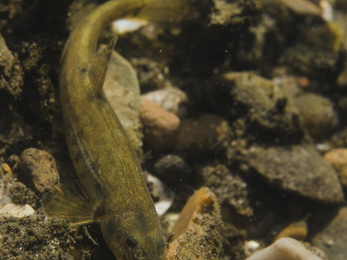We’re nearing the end of the electro-fishing season. In partnership with the Wild Trout Trust we have been strapping on Ghostbusters-style equipment to carry out baselines and repeat surveys at our river restoration sites in the Churnet Valley and the South West Peak. A standout site is on the upper reaches of the River Manifold. To our complete amazement, Atlantic Salmon were found to have spawned in this reach shortly after we had completed a restoration project in 2020. It’s as though they gave our work their seal of approval! This year’s repeat survey demonstrated that, although no additional spawning had taken place last winter, the young Salmon (known as Parr) are still occupying this reach. These represent the most inland records of Salmon for the Humber River Basin and the first modern records for the Peak District National Park. During the latest survey we also recorded Brown Trout, Grayling, Minnow, Bullhead, Stone Loach, and Brook Lamprey.
Leapers & Stone-suckers
River sedge - Ed Marshall
The incredible journeys that Atlantic Salmon attempt, replete with athletic leaps over obstacles, are well documented. The life cycle of the Brook Lamprey is, perhaps, less well known and worth a little further investigation. They are a jawless fish with a design that has endured for over 300 million years. One of the UK’s top Fish gurus, Jack Perks, claims that these primordial critters are so bizarre that Humans are more closely related to Salmon than Salmon are to Lampreys! They have a fascinating life cycle. The adults do not migrate and, despite appearances, are not parasitic. Adults emerge in late March or early April to create a redd (nest) in clean gravels where mating and egg-laying takes place. The adults then die. The eggs hatch shortly afterwards and the larvae (known as Ammocoetes) survive as filter feeders in patches of fine sediment and woody debris in the stream margins or around log jams. After four years the Ammocoetes begin to metamorphose into adults. The whole process can take up to a year. Their eyes and suction disk also develop during this time, while the intestinal tract degenerates and loses its function. Therefore, these fish develop their teeth precisely when they are no longer able to eat! As they emerge from silt bars in the spring to complete their life cycle, the development of the suction disk and the teeth is most likely to help with their ability to grip and move small stones to excavate their nests. Hooray for leapers and stone suckers!
Fish are one of our least recorded groups. This is surprising when you consider how many people regularly visit rivers, streams, ponds, lakes and canals and when you consider the immense popularity of fishing. So, here’s a plea this World Rivers Day: please let us have your fish records! Catch returns from your day’s fishing, glimpses of the darting dash of Brown Trout in your local stream, the stealthy glide of Pike and Perch in a canal near you, and encounters with humble Bullheads and Spined Loach when out stream dipping with the family. And if, by any chance, you’re lucky enough to have witnessed Lamprey nesting, or Salmon leaping, please, please do get in touch. Drop our Records Centre a line. http://www.staffs-ecology.org.uk Thank you.






